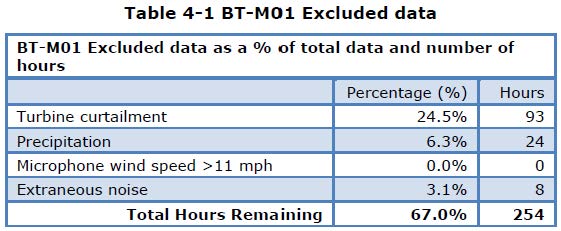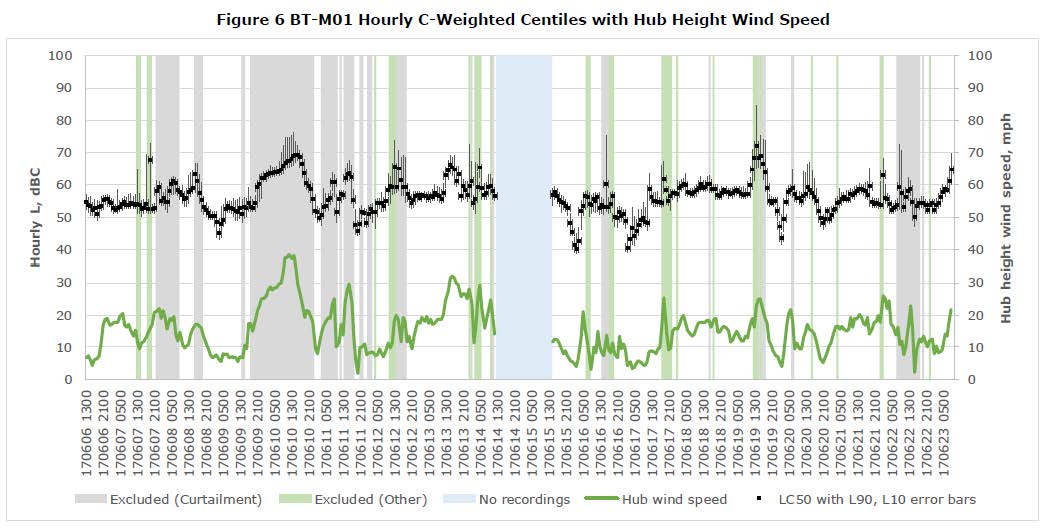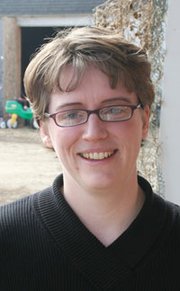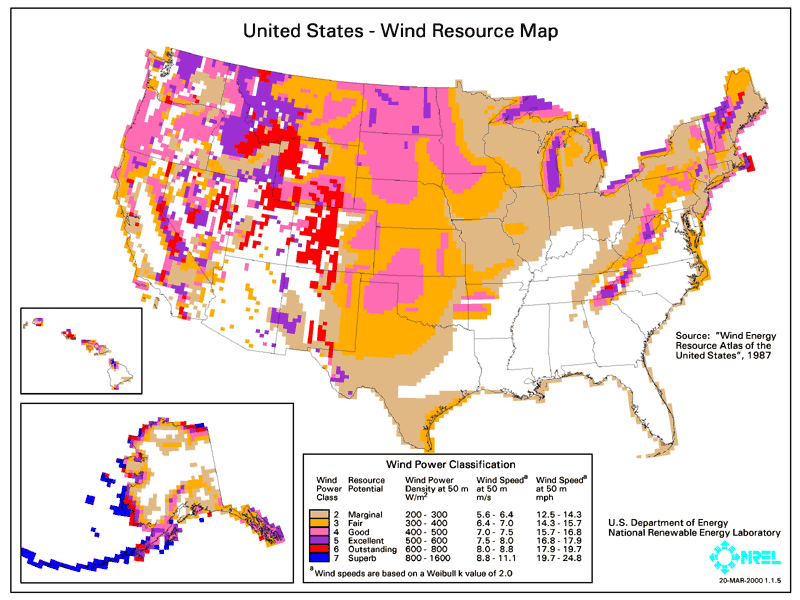Bent Tree – Motion for Order to Show Cause filed today!
February 19th, 2018

Here ’tis:
It’s been years and years, and we’re getting to where administrative remedies are almost exhausted! What more does the Public Utilities Commission need to act?
There’s two studies now showing noise levels above what’s allowed under MPCA rule and the Bent Tree permit.
But wait… there was post-construction monitoring showing the same way back in 2011!
How long does it take to enforce noise regulations? Too long, so far.
Bent Tree – it’s the “dawn chorus”
October 14th, 2017

Wisconsin Power and Light, owner/operator of the Bent Tree Wind project is under the Alliant Energy corporate umbrella. Recently, Wisconsin Power & Light filed a response to the noise study for its Bent Tree wind project:
In this response, well, it’s not wind turbine noise, it’s the birds! It’s the rustling leaves!

Here’s the noise study, in case you missed it:
Bent Tree Wind Farm Noise Monitoring Report
October 2nd, 2017

On April 12, 2017, the Public Utility Commission ordered noise monitoring for the Bent Tree Wind Project after numerous complaints pressured for action on those complaints. Bent Tree is located in Freeborn County just north east of Albert Lea, Minnesota, north of Interstate 90, and on the west side of Interstate 35, opposite where they now want to put up the Freeborn Wind Farm, south of I-90 and east of I-35. They put up monitors at a few locations near the homes of those who filed complaints, and then, for some reason the turbines near those homes are off (Curtailment? Why am I suspicious? Apparently they’ve never been off at other times.). Then they took the monitors away.
But the study is “complete?” Here it is.
On page one, the cover letter, they admit there are times of non-compliance. What’s important in this is that the problematic “noise” is the infrasound, which is found in “C weighted” scales, and not the “A weighted” scale that is the subject of Minn. R. 7030. Further, the Minnesota Rules Ch. 7030 does not address impulsive sounds, such as sounds from a gun range, or some sound from wind turbines.
| 7030.0010 | INCORPORATION BY REFERENCE. |
| 7030.0020 | DEFINITIONS. |
| 7030.0030 | NOISE CONTROL REQUIREMENT. |
| 7030.0040 | NOISE STANDARDS. |
| 7030.0050 | NOISE AREA CLASSIFICATION. |
| 7030.0060 | MEASUREMENT METHODOLOGY. |
| 7030.0070 | SOUND ATTENUATION MEASUREMENT METHODOLOGY. |
| 7030.0080 | VARIANCE. |
MPCA’s Commissioner, John Linc Stein, agrees that the Minnesota Rules do NOT cover infrasound, and there are no rules covering infrasound, but yet will not initiate rulemaking:

WHAT!?!?!?!
Back to the studies. the protocol for the “study” is taken from the Minn. R. Ch. 7030, Measurement Methodology. Monitoring data was excluded if the wind speed was over 11 mph, but for the Langrud monitor, the report says that wind speed was not over 11 mph. Is that reasonable? Look at average wind speeds generally, considering that higher wind speed is desirable for generating electricity (click for larger version):
When wind speeds are high, that is when the noise from the turbines is most unbearable, and under the report protocol, when wind speeds are high, were excluded. Average wind speed n the Bent Tree area is 15.7 – 16.8. So in the chart above, it says 0% were excluded due to high wind. Does that mean there were no times that the wind was over 11 mph? That’s doubtful, although spring and fall are times with higher wind, typically, but, color me skeptical.

But yet Table 4-1 says wind speed did not go over 11 mph during the monitoring, and so no data where wind was over 11 mph was excluded. Curtailment is also unclear, because we do not know what turbines were curtailed, if it was only ones near the monitors, or the entire project (usually is is some but not all). It also says results were skewed by bird chirping and insect noise, which would not have been present in early spring or fall. WHAT?!?! And early spring is planting time so lots of farm equipment out, and fall is harvest. Makes no sense.

So how is the report valid?
Dave Langrud, a landowner in the Bent Tree footprint, has tracked when the turbines were off and on, and we’re working on comparing those times to the times in the report — they do have some info in this report for comparison showing time they admit the turbines were off:

And there were C weighted measurements, note how high these go:

We’ve submitted a Data Practices Act Request for more data:
Nothing has showed up yet.
CUB and WEIG appeal Bent Tree WI PSC decision
September 1st, 2009
I’m representing Safe Wind in Freeborn County, and we’re working to increase the setbacks on the Bent Tree project to something that the neighbors can live with, participating in the PUC Certificate of Need and Siting dockets.
Last Thursday, Citizens Utility Board and Wisconsin Industrial Energy Group filed an appeal of the PSC’s Bent Tree decision.
CUB & WIEG Petition for Review and PSC-WI Bent Tree Decision
I’ve posted their pleadings on the Bent Tree dockets in Minnesota. To review the Bent Tree dockets in Minnesota, go to www.puc.state.mn.us and then click “Search Dockets” and search for dockets 08-573 and/or 07-1425.
Here’s an article about the challenge from the WSJ (Wisconsin State Journal, that is):
More blowback: Suit challenges Alliant wind farm
By Thomas Content of the Journal Sentinel
Aug. 28, 2009State regulators set a bad precedent for other energy projects when they gave the go-ahead to Alliant Energy Corp. to build a $497 million wind farm in Minnesota, two energy customer groups say.
The groups filed suit in Dane County Circuit Court on Friday to protest the vote by the state Public Service Commission to approve the project under a less rigorous review procedure than is typically required of major energy projects.
The Public Service Commission had used the less stringent review process because the project is an out-of-state project. The commission’s approval is needed for out-of-state project because the agency reviews whether a power plant is cost-effective for utility customers.
“Electric rates have been rapidly rising so we simply can’t afford less stringent regulatory review of new energy projects,” said Todd Stuart, executive director of Wisconsin Industrial Energy Group, in a statement. “The cost and need of energy infrastructure can’t be ignored, especially right now with the massive job losses in Wisconsin.”
Rob Crain, a spokesman for Alliant, said the legal challenge could likely mean delays for the project, which is slated to be operational by 2011, Crain said. The wind farm is needed for the utility to comply with the state’s renewable energy mandate that requires 10% of the state’s electricity to come from wind power and other renewable energy sources by 2015, he said.
“We are surprised and certainly disappointed that WIEG and CUB have chosen to make this filing. We view it as more process over substance,” Crain said.
The commission decided in November to move forward with reviewing the project under a less-stringent standard, a decision that was supported by Commissioners Eric Callisto and Mark Meyer but opposed by commissioner Lauren Azar.
“As far as we were concerned the issue was settled at that point in time,” Crain said.
Charlie Higley, executive director of the Citizens’ Utility Board, said the customer groups couldn’t legally file a legal challenge on the issue until after the commission’s final vote on the project in July. In this summer, the groups had warned Alliant’s Madison subsidiary, Wisconsin Power & Light Co., that it was proceeding at its own risk by moving forward with the project under the less-strict review.
The groups are concerned about the precedent the commission’s decision could set for other types of energy projects that utilities could seek to build outside the state’s borders, such as a costly nuclear power plant or coal-fired power plant.
“The bottom line is risk for customers,” Higley said. “And the risk is that poorly designed or expensive projects could be approved and forced on to ratepayers who would then pay higher rates than they should be.”
Bent Tree comment deadline TOMORROW!
July 13th, 2009
 Katie Troe, Safe Wind in Freeborn County
Katie Troe, Safe Wind in Freeborn County
Tomorrow at 4:30 p.m. is the deadline for Comments on the Bent Tree Wind Farm Certificate of Need and Siting docket. This is the 200-400MW wind project that Wisconsin Power & Light wants to build in MINNESOTA for credit towards the Wisconsin Renewable Electricity Standard.
QUICK, send your comments to:
Steve.Mihalchick [at] state.mn.us
For the PUC’s sites, go to www.puc.state.mn.us
Then click on the blue “eDocket” button…
… and search for dockets
08-573 for Siting Docket
07-1425 for Certificate of Need
And there’s also Commerce’s Siting page:
Remember, this is the one that, together with one in Clay County, triggered this White Paper:
Here’s another story in the Albert Lea Tribune with a great “I think they need professional help” quote from Katie Troe:
Safe Wind lobbies state over turbines
By Jason Schoonover | Albert Lea Tribune

